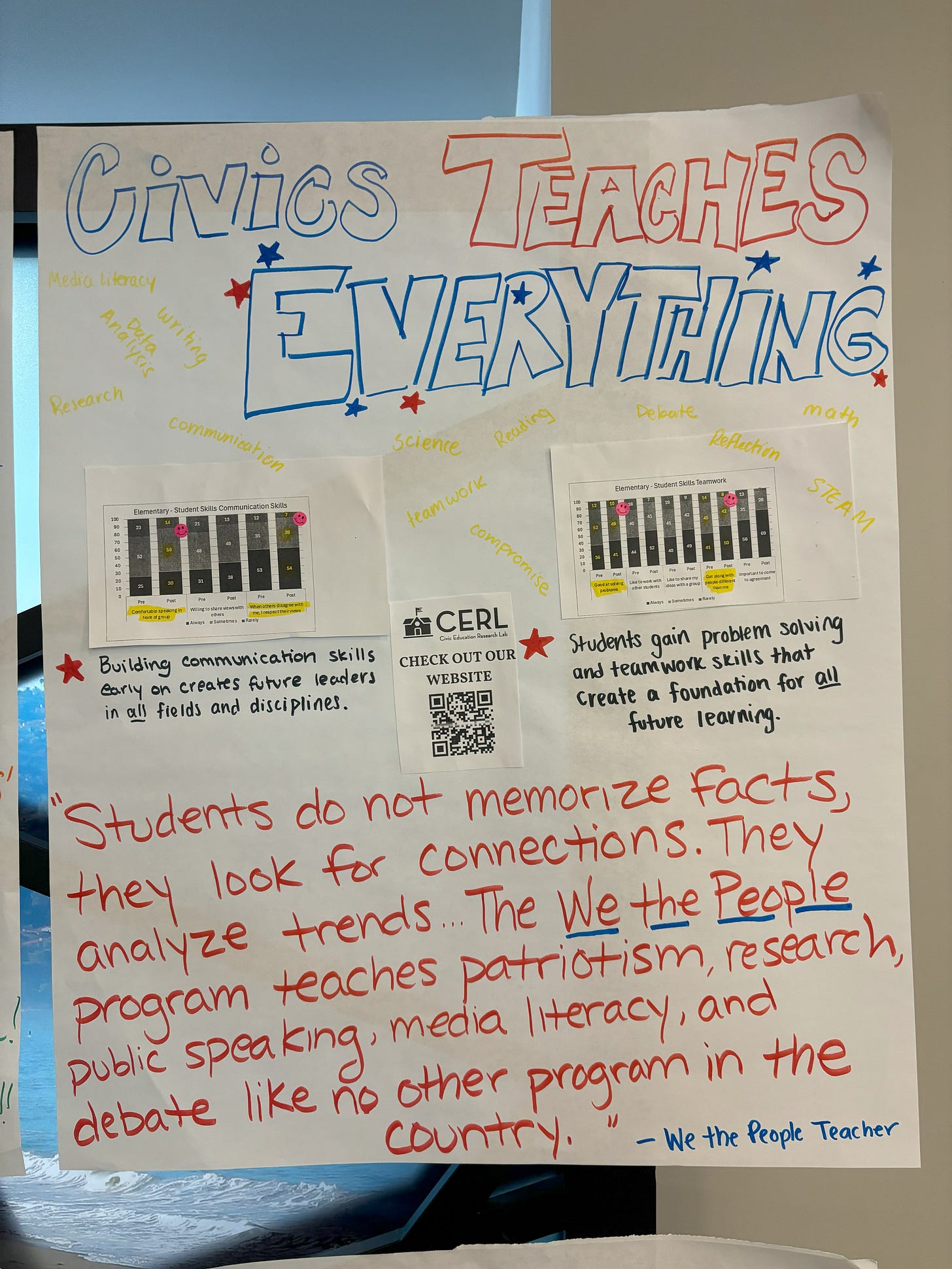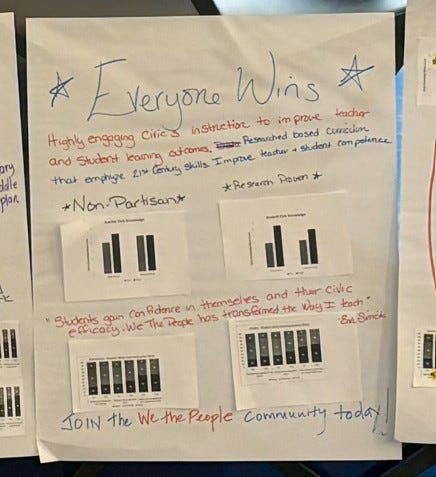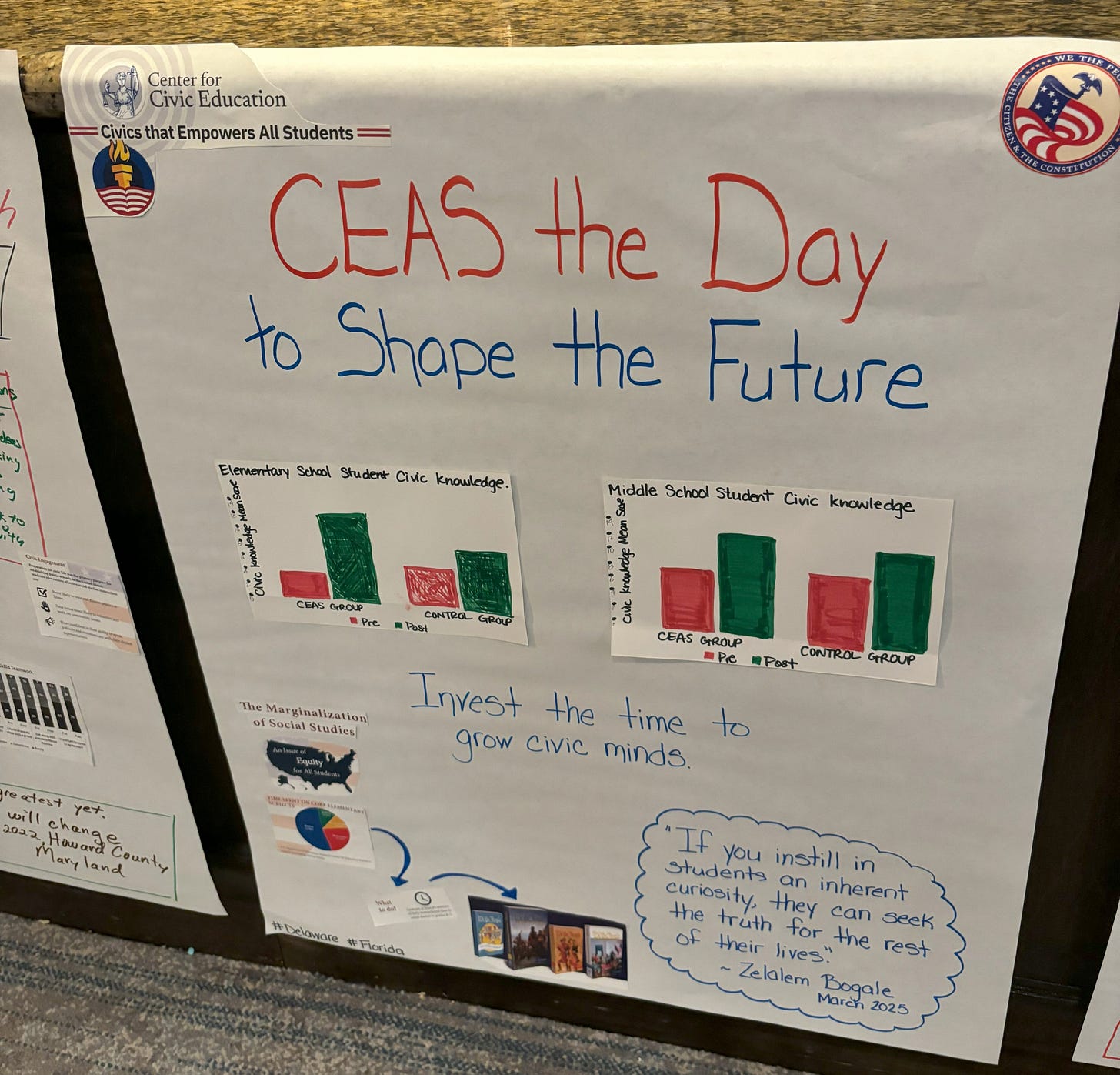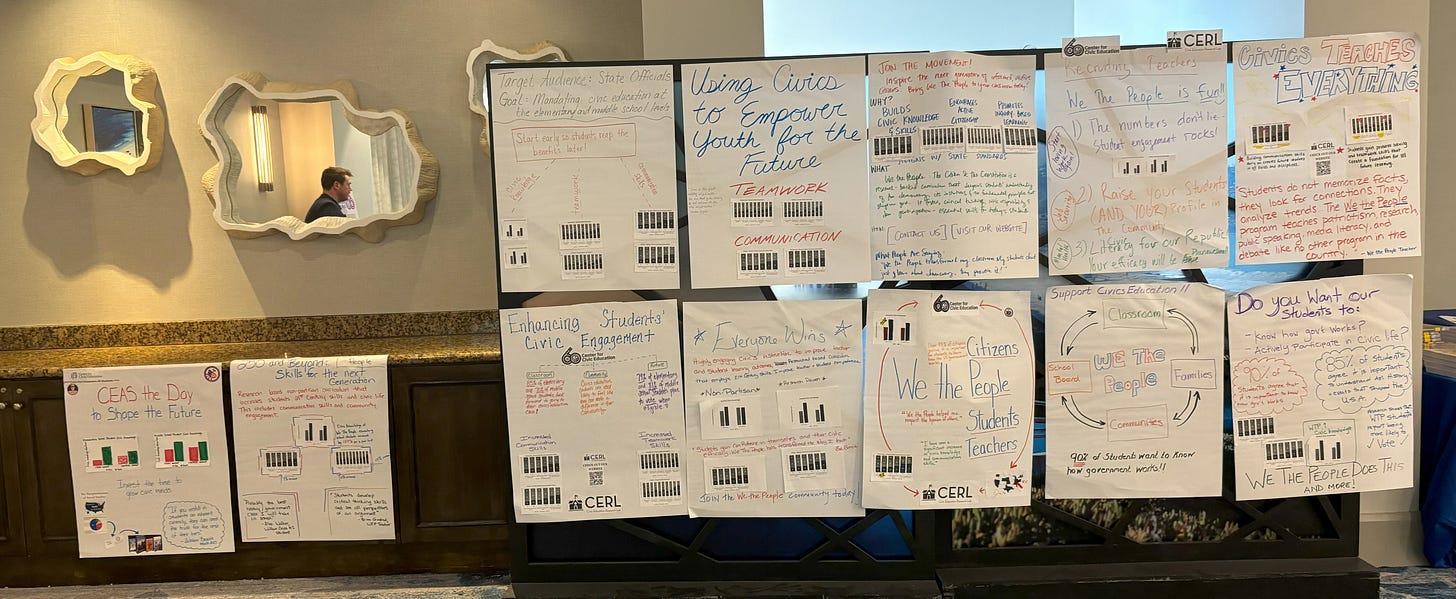At Georgetown University’s Civic Education Research Lab (CERL), we use data to tell the story of the transformative power of civic education. However, the storytelling should not stop with us. Quality data are essential for teachers, administrators, and policymakers to arrive at informed decisions about curricula, pedagogy, and resource allocation. Yet, researchers often fail to convey data in a way that is most useful and interpretable to key stakeholders. The impact of research on education practice and policy can be greatly enhanced when educators are actively involved in data dissemination–when they tell the story.
Research findings are frequently disseminated without consideration of the specialized needs of the audiences they are intended to reach. Investigators, especially those at universities, tend to orient their reports, papers, and publications toward academic audiences. Presentations of study results are often one-sided, as researchers recount statistical findings devoid of context to educators without offering meaningful opportunities to reflect on their relevance. A wide range of constituencies benefit from civic education research, requiring that findings be distributed in a variety of formats. Study reports and publications must maintain high standards of academic rigor as they form the basis of subsequent dissemination efforts. Data storytelling grounded in meticulous scholarly work can be an effective tool for reaching different stakeholders. Storytelling encompasses the use of critical information to create a captivating narrative that informs and influences a target audience (Matei and Hunter, 2021).
It can be difficult for researchers to fully understand best practices for data use by practitioners, and CERL is certainly no exception. We came to recognize that comprehending the composition, needs, and goals of the civic educators we want to reach is vital to the success of our work. When disseminating our research, it is imperative that we ask: Who is using the data? For what purpose? In what context? And with what desired outcome? Fortunately, research specialists on the CERL team have elementary and secondary school teaching experience. We brainstormed about ways to get teachers involved in telling the story of our data and created a professional learning session entitled Campaigning for CEAS: Using Data & Design to Create a Compelling Story to actively engage educators in data storytelling. We implemented this activity at a workshop convened by the Center for Civic Education for the We the People: Civics that Empowers All Students (CEAS) program, an initiative that supports effective educator development through the Center’s flagship We the People curriculum. The workshop was held in Los Angeles in March 2025. CERL is the independent evaluator of the CEAS program which was funded by a grant from the U.S. Department of Education.
The workshop was attended by mentor teachers who work with classroom educators enrolled in CEAS and state coordinators who support the Center’s programs nationwide. The CEAS program provides professional development to guide upper elementary and middle school teachers in instructing the We the People curriculum with their students. CERL’s research evaluates the effectiveness of the CEAS professional development program in improving teachers’ civic knowledge and pedagogy. It also assesses the impact of the We the People intervention on students’ civic knowledge, skills, and dispositions.
We began the session by presenting CERL’s research findings on the impact of CEAS on teachers and students who had participated in the program. We provided workshop participants with a handout summarizing key points of our presentation. We asked them to take a deeper look at the research and identify the data that would be most useful if they were to advocate for using the We the People curriculum in their own classrooms, schools, districts, or states. Working in groups, the educators combined the data presented by CERL with their personal reflections to create a poster. Groups began by identifying their target audience–parents, teachers, school administrators, district leaders, or state policymakers. Next, groups determined the goal of their poster. Were they trying to inform parents of the program's success? To recruit other educators to participate in the study? To convince administrators to adopt We the People as a district wide curriculum? Or were they trying to advocate for policies that provide funding for civic education at the state-level? They reviewed the handout which included data visualizations that could be customized, cut, and pasted onto their poster. Since qualitative evidence is essential for data storytelling, we asked groups to reflect on their experiences with CEAS and include a quote from their discussion on their poster.
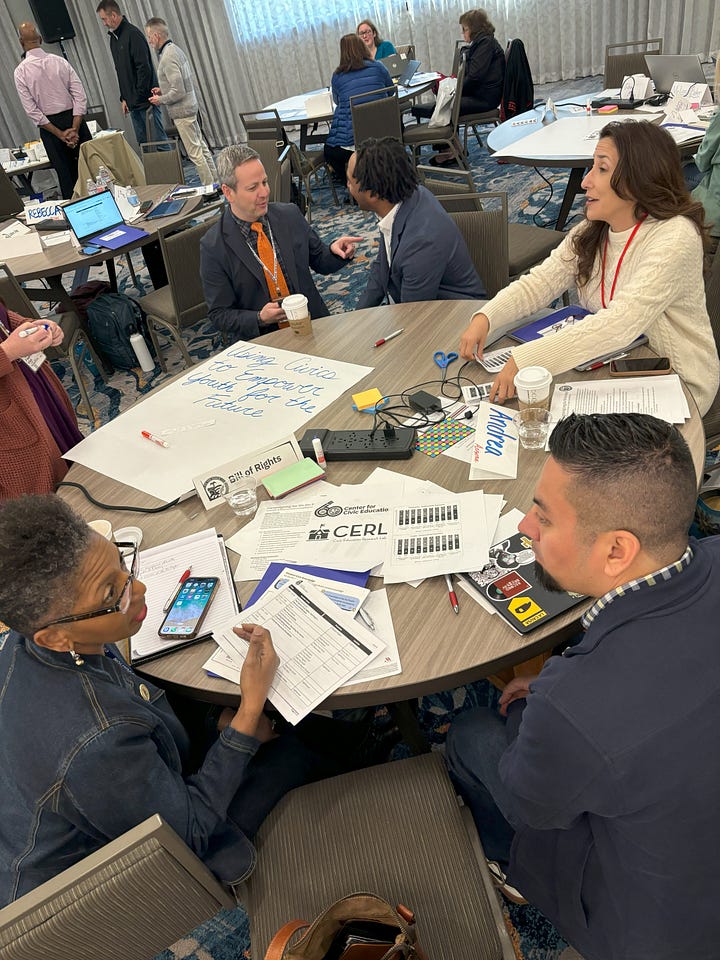
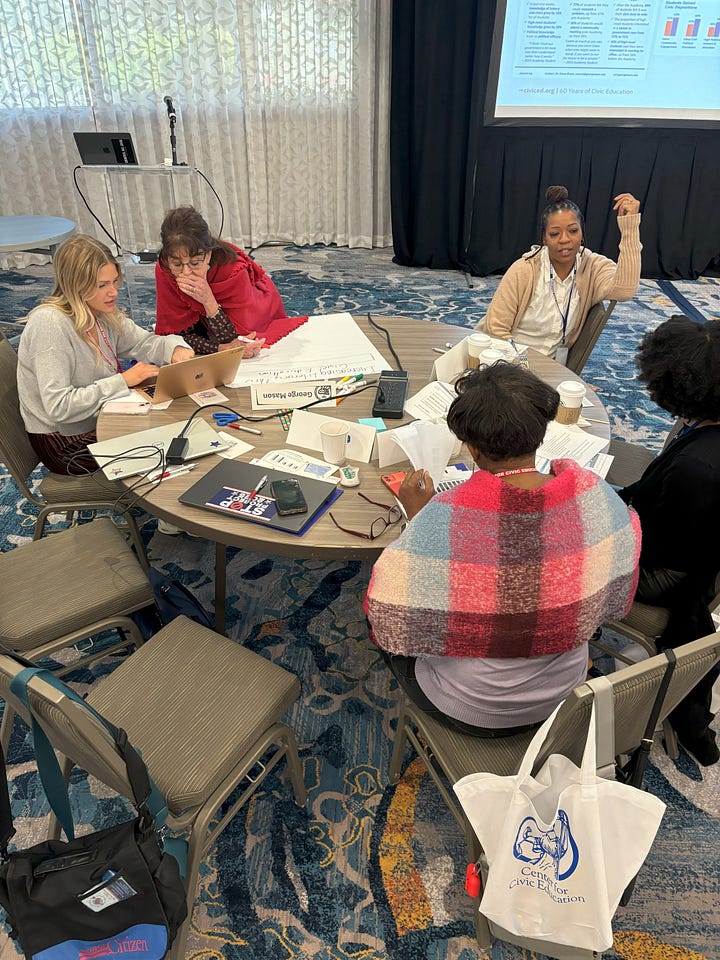
Each table buzzed with creative ideas as the activity transformed the conference room into an innovation hub. Groups were provided with poster boards, stickers, markers, and other craft supplies. Educators dove headfirst into the research, collaborating to determine what data best illustrated the impact of CEAS to reach their target audience and goals. While all posters emphasized that We the People students had gained civic knowledge and skills, each poster told its own story, capturing unique perspectives on the program's impact. Common themes emphasized the need to start civic education early and the benefits of We the People in teaching 21st century skills.
A poster entitled “Civics Teaches Everything” emphasized how the communication skills students built through We the People can translate to “all fields and disciplines.” This group identified how problem solving and teamwork skills create a “foundation for future learning.” They expressed the importance of the program’s active learning strategies to advocate for its implementation in schools. This emphasis reflects the findings of prior research, including CERL’s studies, that establishes a positive relationship between active pedagogies and civic learning outcomes (Owen and Irion-Groth, 2024; Kozanitis and Nenciovici, 2023).
Another poster entitled, “Everyone Wins” highlights improvement in students' confidence and civic efficacy. This poster’s creators aimed to reach teachers who might be discouraged or intimidated by the competitive components of the We the People program which culminates in simulated congressional hearings. Classes have the potential to participate in district, state, and national civics competitions, although this is not a program requirement. The poster stressed that all students will win the prize of enhanced civic knowledge and skills.
Lastly, the poster “CEAS the Day to Shape the Future” was created to persuade policy makers to “Invest the time to grow civic minds.” This group emphasized the discrepancy between time spent on social studies compared to other subjects and calls for policy makers to invest in civic education.
The session culminated in a gallery walk to celebrate the creative and persuasive visualizations which sparked meaningful conversations. The exercise generated positive feedback in the moments and months following the session. A participant observed, “This is interesting because if you were trying to sell this to a district, or sell it to teachers, or trying to get people to do it, that was really good info, that was really good research." Another noted, “This activity helped make the connection between what the aim of the program was and what the actual results are.”
This hands-on activity left participants with deeper insights into the data and provided CERL with a better understanding of what stories educators seek to tell. It empowered us all to enhance the way we advocate for civic education. We encourage researchers and educators to find creative ways to bridge the gaps between research, policy, and practice and to make data accessible and useful to stakeholders. It was inspiring to see educators creatively integrate data into powerful stories that advocate for civic education. When we infuse the voices of educators into the research process and equip them with the tools for data-driven advocacy, we co-create meaningful, impactful, and sustainable education programs.
Dr. Diana Owen, Director of CERL
Dr. Patrick McSweeney, Jamie Joseph, and Naomi Rader, CERL Research Specialists
References
Kozanitis, A. and Nenciovici, L. 2023. Effect of Active Learning Versus Traditional Lecturing on the Learning Achievement of College Students in Humanities and Social Sciences: A Meta-Analysis. Higher Education, 86, 1377–1394. https://doi.org/10.1007/s10734-022-00977-8
Matei, Sorin Adam, and Lucas Hunter. 2021. “Data Storytelling Is Not Storytelling with Data: A Framework for Storytelling in Science Communication and Data Journalism,” The Information Society, 37(5): 312-322. https://doi.org/10.1080/01972243.2021.1951415
Owen, Diana, and Alissa Irion-Groth. 2024. “Preparing Students for Civic Engagement through Project Citizen,” paper prepared for presentation at the Annual Meeting of the American Political Science Association, Philadelphia, PA, September 6. Preparing Students for Civic Engagement through Project Citizen | Political Science Education and the Profession | APSA Preprints | Cambridge Open Engage (apsanet.org)

